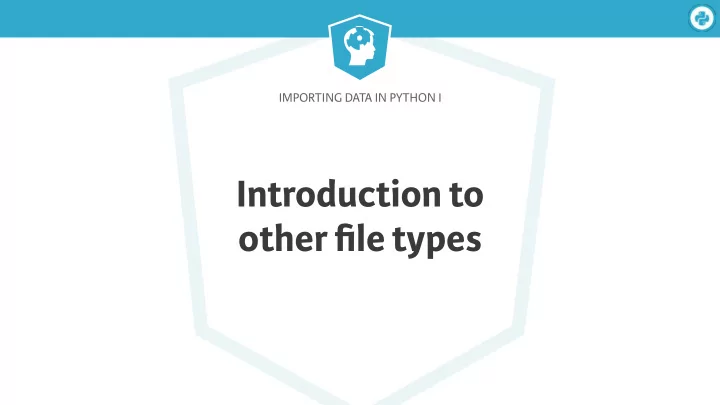

IMPORTING DATA IN PYTHON I Introduction to other file types
Importing Data in Python I Other file types ● Excel spreadsheets ● MATLAB files ● SAS files ● Stata files ● HDF5 files
Importing Data in Python I Pickled files ● File type native to Python ● Motivation: many datatypes for which it isn’t obvious how to store them ● Pickled files are serialized ● Serialize = convert object to bytestream
Importing Data in Python I Pickled files In [1]: import pickle In [2]: with open('pickled_fruit.pkl', 'rb') as file: ...: data = pickle.load(file) In [3]: print(data) {'peaches': 13, 'apples': 4, 'oranges': 11}
Importing Data in Python I Importing Excel spreadsheets In [1]: import pandas as pd In [2]: file = 'urbanpop.xlsx' In [3]: data = pd.ExcelFile(file) In [4]: print(data.sheet_names) ['1960-1966', '1967-1974', '1975-2011'] In [5]: df1 = data.parse('1960-1966') sheet name, as a string sheet index, as a float In [6]: df2 = data.parse(0)
Importing Data in Python I You’ll learn: ● How to customize your import ● Skip rows ● Import certain columns ● Change column names
IMPORTING DATA IN PYTHON I Let’s practice!
IMPORTING DATA IN PYTHON I Importing SAS/Stata files using pandas
Importing Data in Python I SAS and Stata files ● SAS: Statistical Analysis System ● Stata: “Statistics” + “data” ● SAS: business analytics and biostatistics ● Stata: academic social sciences research
Importing Data in Python I SAS files ● Used for: ● Advanced analytics ● Multivariate analysis ● Business intelligence ● Data management ● Predictive analytics ● Standard for computational analysis
Importing Data in Python I Importing SAS files In [1]: import pandas as pd In [2]: from sas7bdat import SAS7BDAT In [3]: with SAS7BDAT('urbanpop.sas7bdat') as file: ...: df_sas = file.to_data_frame()
Importing Data in Python I Importing Stata files In [1]: import pandas as pd In [2]: data = pd.read_stata('urbanpop.dta')
IMPORTING DATA IN PYTHON I Let’s practice!
IMPORTING DATA IN PYTHON I Importing HDF5 files
Importing Data in Python I HDF5 files ● Hierarchical Data Format version 5 ● Standard for storing large quantities of numerical data ● Datasets can be hundreds of gigabytes or terabytes ● HDF5 can scale to exabytes
Importing Data in Python I Importing HDF5 files In [1]: import h5py In [2]: filename = 'H-H1_LOSC_4_V1-815411200-4096.hdf5' In [3]: data = h5py.File(filename, 'r') # 'r' is to read In [4]: print(type(data)) <class 'h5py._hl.files.File'>
Importing Data in Python I The structure of HDF5 files In [5]: for key in data.keys(): ...: print(key) meta quality strain In [6]: print(type(data['meta'])) <class 'h5py._hl.group.Group'>
Importing Data in Python I The structure of HDF5 files In [7]: for key in data['meta'].keys(): ...: print(key) Description DescriptionURL Detector Duration GPSstart Observatory Type UTCstart In [8]: print(data['meta']['Description'].value, data['meta'] ['Detector'].value) b'Strain data time series from LIGO' b'H1'
Importing Data in Python I The HDF Project ● Actively maintained by the HDF Group ● Based in Champaign, Illinois
IMPORTING DATA IN PYTHON I Let’s practice!
IMPORTING DATA IN PYTHON I Importing MATLAB files
Importing Data in Python I MATLAB ● “Matrix Laboratory” ● Industry standard in engineering and science ● Data saved as .mat files
Importing Data in Python I SciPy to the rescue! ● scipy.io.loadmat() - read .mat files ● scipy.io.savemat() - write .mat files
Importing Data in Python I What is a .mat file?
Importing Data in Python I Importing a .mat file In [1]: import scipy.io In [2]: filename = 'workspace.mat' In [3]: mat = scipy.io.loadmat(filename) In [4]: print(type(mat)) <class 'dict'> In [5]: print(type(mat['x'])) <class 'numpy.ndarray'> ● keys = MATLAB variable names ● values = objects assigned to variables
IMPORTING DATA IN PYTHON I Let’s practice!
Recommend
More recommend